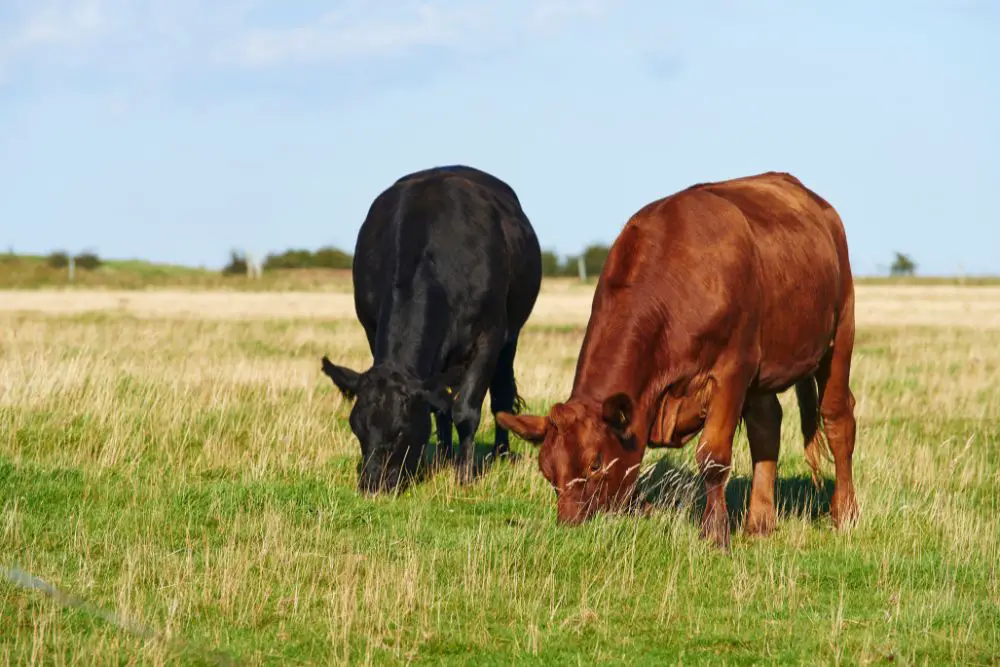Gelbvieh cattle have the largest ribeye-muscle area per 220 pounds than any other beef breed. They also reach puberty early and surpass all other breeds, which leads to reproducing larger herds much sooner.
The history of Gelbvieh cattle may not be as rich as that of most other breeds like Brahman and Red Angus, but they still play an important role in the world beef industry.
Table of Contents
Where Do The Gelbvieh Cattle Come From?
Gelbvieh cattle originated in the 1800s from Franconian districts in Northern Bavaria, Southern Germany, where they were reared as a triple-purpose breed for draft power, milk production, and meat.
The breed is also called Einfarbig gelbes or German Yellow. The name Gelbvieh, pronounced as Gelp-fee, means “yellow cattle” in German.
Gelbvieh cows and bulls evolved from around 1850 through the breeding of local strains of Red-yellow Franconian cattle to eventually form the modern Gelbvieh breed by 1920.
Some of the local traits or strains used to develop the Gelbvieh include the Glan, the Limpurger, Donnersberg, the Old Franconian Red Land-race cattle, the Scheinfeld, the Lahn, and the Elling-Weissenburg.
All the red-yellow strains and breeds were brought together under the same umbrella in 1953 with the collective name of Gelbvieh or German Yellow.
The breed’s development led to the formation of associations such as the Breed Society for Yellow Franconia Cattle for Middle and Upper Franconia in 1897 and the Breed Society for Gelbvieh in Lower Franconia in 1899.
For about a century, the Gelbvieh cattle breed developed in Germany and didn’t travel farther afield until the 1970s. The Gelbvieh first found their way to the US in 1971 when Leness Hall of Carnation Genetics imported 43,000 units of semen.
The American Gelbvieh Association (AGA) was established in the same year to promote the breed and provide members programs and services to advance the cattle in the country.
Since the breed’s arrival in North America, the US Meat Animal Research Center in Nebraska became instrumental in scrutinizing and popularizing the breed around the Clay center and southern Nebraska.
Other importations of Gelbvieh cattle were made to Canada, South Africa, Great Britain, Zimbabwe, Portugal, Zambia, and Spain.
Today, Gelbvieh bulls and cows are reared as a dual-purpose breed for milk and beef production.
Gelbvieh are also used for crossbreeding with other cattle breeds to produce hybrids like the Balancer, which was developed and trademarked by the AGA as a cross between Gelbvieh and Red or black Angus cattle.
Gelbvieh Cattle Breed Characteristics
Gelbvieh cattle depict the following attributes:
| Official Breed Name | Gelbvieh |
| Origin | Germany |
| Appearance | Medium to large-sized, muscular animals Solid black color or reddish gold to russet (pure golden brown) Strong, dark hooves Naturally horned. Most are now genetically polled. Small, straight-profiled face that resembles a heart Short, fine hair Deep-hued skin pigmentation |
| Average Calf Weight | 83 pounds (female), 88 pounds (male) |
| Mature Cow Weight | 1,400-1,600 pounds |
| Mature Cow Height | 54-57 inches at the withers |
| Mature Bull Weight | 2,200-2,800 pounds |
| Mature Bull Height | 58-62 inches at the withers |
| Ready To Breed | 13 months of life |
| Gestation Period | 9 months |
| First Calvings | 22 months of age |
| Time to Slaughter | 2 years |
| Carcass Weight | 944 pounds |
| Expected Lifespan | 10+ years |
| Productive Lifespan | 4+ years |
| Known For | Early puberty and high fertility Remarkable ribeye-muscle area Docility, with a demonstrated quiet temperament |
| Weaknesses | Medium to late maturing Difficulty in attaining purebred animals (those below 88% Gelbvieh are recognized only as Percentage Gelbvieh) Slightly aggressive |
| Climate | Adaptable to many climates |

What Is So Special About Gelbvieh Cattle?
Gelbvieh cattle are a unique breed with several advantages and almost no shortcomings. Here’s why they are popular in the cattle industry:
- Early puberty, surpassing all other beef breeds
- High fertility in bulls due to large testicular size. (This fertility is seen in the bull’s female offspring).
- Largest ribeye-muscle area per 220 pounds, surpassing all other beef breeds
- Excellence at the totality of combined aspects of milk yield, weaning growth, calving ease, saleable meat, and yearling growth.
- High weaning weights for age
- Well-defined udders with protective skin pigmentation
- Good milking ability
- Tender, uniformly marbled beef
- Persistent pregnancies and ease of conception
- Ability to survive in the sun
- Great maternal traits
- Above standard muscling and good growth rates due to feed efficiency
- Excellent genetics, which breeders use to pass traits like quiet temperament, maternal traits, increased stayability or longevity, hybrid vigor, weaner marketability, and early puberty.
Why Should I Raise Gelbvieh Cattle On My Farm?
As mentioned, Gelbvieh cows and bulls are an all-good breed with nearly no disadvantages, except for the difficulty of attaining purebreds.
You’ll love Gelbvieh cattle on your farm since they are highly adaptable to hot environments and resistant to sun damage because of their skin pigmentation. However, most prefer to take refuge under a shade most of the time.
Gelbvieh cattle are also easier to raise because they have been reported as resistant to parasites like ticks. In Australia and South Africa, they have been reported to starve ticks by restricting blood flow to areas bitten by the ticks, although this phenomenon is still under investigation.
The uniform marbling and large ribeye-muscle area mean higher profitability as people seek Gelbvieh beef for these attributes.
You may also want to raise Gelbvieh cattle to tap into their unique genetics for crossbreeding with other European breeds of cattle to enhance hybrid vigor, agreeable temperament, and early puberty attainment in your herd.
